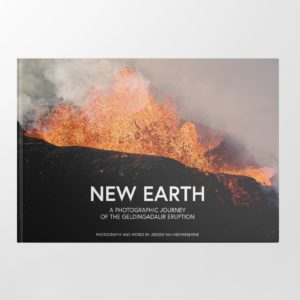The Canon EOS R5 Mark II has finally been unveiled to the world! Because this new model seems to be an incremental update, I was initially not that excited as a photographer. However, a bit more digging into the specifications allowed me to discover that there are definitely a few interesting improvements over its predecessor, the Canon EOS R5, which I have been using for the last year.
In this article, I have listed five improvements that stood out to me and could really improve my quality of life as a photographer. Let’s get one thing out of the way before we get going: I am not focusing on videography and none of the video improvements in this new camera body are of any particular interest to me. I really look at this new camera from the perspective of a landscape and wildlife photographer only.
If you are interested in a full list of specifications of the Canon EOS R5 Mark II, make sure to check Canon’s website.
Disclaimer: I did not get my hands on a preview model of the Canon EOS R5 Mark II. This is an opinion article based on all the available information of this camera body at the time of writing. This article is not sponsored in any way. However, when you make a purchase using the link in this article, I may earn a small commission.

While I have used the Canon EOS R5 for only one year, I have grown to love the extra resolution it has given me over my trusty Canon EOS R6.

I have taken my Canon EOS R5 to all kinds of amazing places such as Antarctica and Patagonia. While it’s a very capable camera, there are a few things I would love to see improve on the Canon EOS R5 Mark II.
1. Battery Life Improvements
As we’ve grown to expect from Canon cameras over the years, for the most part, older batteries have remained usable whenever a new body releases. Coming from the Canon EOS 5D Mark IV, to the Canon EOS R, the Canon EOS R6 and eventually the Canon EOS R5, the batteries I own have always continued on with my new camera body. They have always stayed the same shape and never differed aside from minor changes (voltage) between the LP-E6, LP-E6N & LP-E6NH). This is no different with the Canon EOS R5 Mark II.
One minor annoyance with the Canon EOS R5 is that the battery life was on the low end, especially when comparing it to my previous camera bodies. As I was hoping, this has dramatically improved with the release of the Canon EOS R5 Mark II, which is now rated for 630 shots (using the screen) and 340 shots (using the EVF). This is up from 490 shots (using the screen) and 320 shots (using the EVF). The reason the rating when using the EVF hasn’t improved much is likely due to the higher brightness and resolution of that EVF. The Canon EOS R5 Mark II comes with a slightly different battery again (the LP-E6P), which is needed to power the highest burst mode and some 8K video features.
To me, any kind of battery life improvement is a major plus as it means bringing less batteries and even going back to relying on just a single battery throughout the day (for my style of shooting).
When I captured the northern lights above this ongoing eruption, I kept shooting while using the articulating screen on my Canon EOS R5. With this improved battery life, I could have gotten even more shots out of the situation without having to stop to change batteries (vital during timelapses).
2. Greatly Improved Autofocus & Eye-Control Autofocus
While the autofocus capabilities of the original Canon EOS R5 weren’t bad at all, Canon really upped the game by improving it even more. The Canon EOS R5 Mark II borrows the autofocus capabilities of Canon’s new flagship camera, the Canon EOS R1, aided by the new DIGIC Accelerator coprocessor. That in essence means that the autofocus will be much more capable at automatically detecting subjects and even keep focus while the subject is obscured by something else. For me as a wildlife photographer, that should hopefully mean my camera will keep focus even better than it already did and should struggle less with grass obscuring birds, just to name one example. The coprocessor also allows you to focus in darker settings than before, albeit not by much.
The Canon EOS R5 Mark II also borrows the Eye-Control autofocus system from the Canon EOS R3. This means that your camera now tracks what you are looking at to determine focus. I have tested this in the past on the Canon EOS R3 and, once calibrated, I was positively surprised at how well it works.
In more challenging situation, such as extremely snowy conditions, potential issues with obstruction of the subject shouldn’t be a problem either. While I didn’t have any real issues when taking this photograph during the Antarctica photo workshop, there were times during this zodiac outing where I wouldn’t have been opposed to faster autofocus in rough conditions.
3. A New Back-Illuminated Stacked CMOS Sensor
While the megapixel count didn’t improve, the sensor technology did. This time there’s a new, Canon-developed, back-illuminated stacked CMOS sensor, which captures RAW images with 14 bit colour depth. This brings some new advantages such as no blackout on the EVF while shooting, faster readout speed while shooting (minimal rolling shutter), improved image quality and better low light performance. With the new DIGIC Accelerator coprocessor, the Canon EOS R5 Mark II is capable of the fastest image processing in a Canon camera to date.
I always tend to take these kind of claims with a grain of salt but it will be interesting to see how this sensor will stack up against the previous model when it releases later this summer. However, according to some reviewers, the noise control is really well up to even sensitivities of ISO 25600!
4. Finally: Pre-Capture or Pre-Continuous Shooting!
While this feature had been rumoured to be included in a version 2.0 of the Canon EOS R5 firmware, it seems like Canon held it off for the new model. Pre-capture means that the camera begins capturing images when pressing the capture button half-way down. It then retains the most recent 0,5 seconds of RAW images for as long as you keep the shutter button half-way down. It is basically shooting before you fully press the shutter, making sure you never miss a moment. In practice, this will mean the Canon EOS R5 Mark II saves up to 15 RAW images before the first shot you actually intended to take. This can be a game-changer for wildlife photographers and it’s a feature I have been waiting for. It’s small improvements such as this one that can dramatically increase your keeper rate.
Right before I captured this shot of these two arctic fox cubs playing, they were in a much more interesting position. If I would have had pre-capture available to me at that time, I would have definitely come away with an image I would have been even happier with.
Just moments before during this Puffins in the Midnight sun photo workshop, this puffin also had its bill open while holding the same position. If pre-capture would have been available to me at the time, I would have definitely gotten an even more interesting shot.
5. Out-Of-Focus & Blur Detection
While this may seem like a small addition, the new ‘out-of-focus & blur detection’ can be a game-changer in the field. Especially within bird photography, it can be very difficult to determine whether the image you capture was sharp and in focus on the EVF or screen of the camera. With the Canon EOS R5 Mark II, Canon added a new feature that allows you to more easily detect out-of-focus and blurry images when reviewing them. Bear in mind: this won’t work on images taken before enabling the feature. Again, it’s small quality of life improvements such as this one that I value the most.
When I captured this shot on the Antarctica photo workshop, which I took at 500mm from a moving ship, I remember being stressed about whether or not it worked out. It’s in moments like that, this ‘out-of-focus and blur detection’ feature would have given me a lot of peace of mind.
Other Minor Notable Improvements To The Canon EOS R5 Mark II
These 5 are, to me, the major improvements for photographers. However, there are a few smaller improvements that stood out to me:
- There is now a dedicated switch between photo and video mode. I can’t explain how much more convenient this is compared to the previous method (press the mode dial, press Info, go into the video modes).
- The Canon EOS R5 Mark II now comes with the same ‘intelligent’ multifunctional hot shoe design as was introduced on the Canon EOS R6 Mark II. I am eager to see what kind of useful accessories will be released (DJI Mic Receiver mount anyone?)
- It’s possible to up-scale, and even noise reduce, images in the camera itself. However, these features have to be applied after taking the shot.
- The speed at which you shoot in burst mode can now be controlled in a more refined way, allowing you to set continuous shooting at 30, 20, 15, 12, 10, 7.5, 5, 3, 2 or 1 fps.
Conclusion
While I had expected more, and perhaps I even set myself up for disappointment, there are quite a few notable changes that could bring real world quality of life improvements to my workflow. I am likely going to get a Canon EOS R5 Mark II to replace my primary camera body some time this year. As always, I will keep you posted on my findings after using it extensively for a while. Stay tuned!
Discover Jeroen’s Photo Workshops in Iceland, Greenland & Beyond
Ready to take your photography to the next level? Join me, Jeroen Van Nieuwenhove, on unforgettable photo workshops in Iceland, Greenland, Antarctica and other exciting destinations. Whether your passion is wildlife photography, bird photography, landscape adventures, or mastering drone photography, each workshop is designed to give you hands-on guidance in some of the world’s most spectacular locations.
From puffins in the midnight sun to Arctic foxes in the wild, from glaciers and volcanoes to dramatic coastlines seen by drone – these journeys are more than workshops; they’re once-in-a-lifetime experiences. Group sizes are kept small, ensuring personal mentoring and plenty of shooting opportunities.
Looking for something specific? Check out Jeroen’s…
- Wildlife & Bird Photography Workshops (Puffins, Arctic Foxes)
- Drone Photography Workshops
- Photo Workshops in Iceland
- Photo Workshops in Greenland
Spots are limited – secure your place today!
What Previous Participants Shared About Their Experience
These reviews are verifiable on Jeroen’s public Google Business profile.
Support Jeroen’s Work
As an independent photographer, Jeroen partially relies on your support to keep producing worthwhile content such as blogs, photographs, books and much more. If you want to support his work, it is possible to do so by buying his e-books & books or prints.
You can also sign up to the newsletter to stay up to date on new blog posts, projects, workshops and other interesting information.
Thank you for considering!























